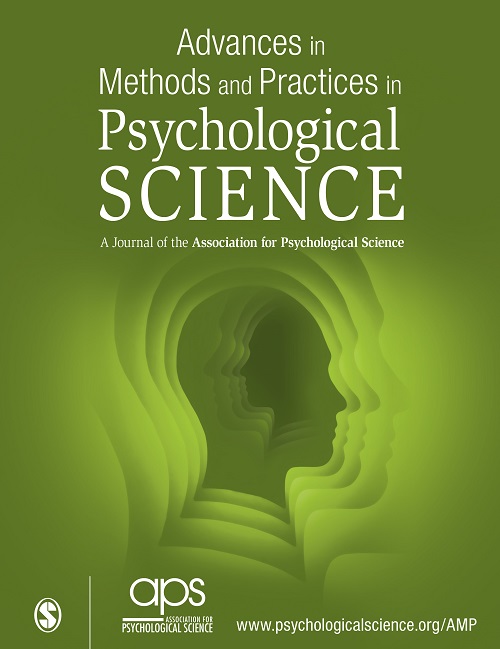结构方程模型图和有向无环图的初步研究:何时以及如何在心理和流行病学研究中使用它们
IF 13.4
1区 心理学
Q1 PSYCHOLOGY
Advances in Methods and Practices in Psychological Science
Pub Date : 2023-04-01
DOI:10.1177/25152459231156085
引用次数: 2
摘要
许多心理学研究人员在研究过程中使用某种形式的视觉图表。与结构方程模型(SEM)和因果有向无环图(DAG)一起使用的模型图可以指导因果推理研究。SEM图和DAG在视觉上有着共同的相似之处,经常让熟悉其中一种的研究人员想知道另一种是如何不同的。本文旨在为心理科学和精神流行病学的研究人员提供关于这些方法之间区别的指南。我们通过一个指导性的例子对SEM和因果DAG进行了高层次的概述。然后,我们比较和对比这两种方法,并描述何时使用每种方法。简言之,SEM图既是一种概念工具,也是一种统计工具,在其中绘制模型并进行测试,而因果DAG只是一种概念性工具,用于帮助指导研究人员制定分析策略和解释结果。因果DAG是因果推断的明确工具,而SEM的结果有时只是因果解释。DAG可以被认为是一些SEM的“定性示意图”,而SEM可以被认为为因果DAG的“代数系统”。随着心理学开始采用更多的因果建模概念,精神流行病学开始采用更多潜在变量概念,研究人员理解并可能结合这两种工具的能力是有价值的。使用一个应用示例,我们提供了SEM和因果DAG方法的样本分析、代码和总结。本文章由计算机程序翻译,如有差异,请以英文原文为准。
A Primer on Structural Equation Model Diagrams and Directed Acyclic Graphs: When and How to Use Each in Psychological and Epidemiological Research
Many psychological researchers use some form of a visual diagram in their research processes. Model diagrams used with structural equation models (SEMs) and causal directed acyclic graphs (DAGs) can guide causal-inference research. SEM diagrams and DAGs share visual similarities, often leading researchers familiar with one to wonder how the other differs. This article is intended to serve as a guide for researchers in the psychological sciences and psychiatric epidemiology on the distinctions between these methods. We offer high-level overviews of SEMs and causal DAGs using a guiding example. We then compare and contrast the two methodologies and describe when each would be used. In brief, SEM diagrams are both a conceptual and statistical tool in which a model is drawn and then tested, whereas causal DAGs are exclusively conceptual tools used to help guide researchers in developing an analytic strategy and interpreting results. Causal DAGs are explicitly tools for causal inference, whereas the results of a SEM are only sometimes interpreted causally. A DAG may be thought of as a “qualitative schematic” for some SEMs, whereas SEMs may be thought of as an “algebraic system” for a causal DAG. As psychology begins to adopt more causal-modeling concepts and psychiatric epidemiology begins to adopt more latent-variable concepts, the ability of researchers to understand and possibly combine both of these tools is valuable. Using an applied example, we provide sample analyses, code, and write-ups for both SEM and causal DAG approaches.
求助全文
通过发布文献求助,成功后即可免费获取论文全文。
去求助
来源期刊
CiteScore
21.20
自引率
0.70%
发文量
16
期刊介绍:
In 2021, Advances in Methods and Practices in Psychological Science will undergo a transition to become an open access journal. This journal focuses on publishing innovative developments in research methods, practices, and conduct within the field of psychological science. It embraces a wide range of areas and topics and encourages the integration of methodological and analytical questions.
The aim of AMPPS is to bring the latest methodological advances to researchers from various disciplines, even those who are not methodological experts. Therefore, the journal seeks submissions that are accessible to readers with different research interests and that represent the diverse research trends within the field of psychological science.
The types of content that AMPPS welcomes include articles that communicate advancements in methods, practices, and metascience, as well as empirical scientific best practices. Additionally, tutorials, commentaries, and simulation studies on new techniques and research tools are encouraged. The journal also aims to publish papers that bring advances from specialized subfields to a broader audience. Lastly, AMPPS accepts Registered Replication Reports, which focus on replicating important findings from previously published studies.
Overall, the transition of Advances in Methods and Practices in Psychological Science to an open access journal aims to increase accessibility and promote the dissemination of new developments in research methods and practices within the field of psychological science.

 求助内容:
求助内容: 应助结果提醒方式:
应助结果提醒方式:


